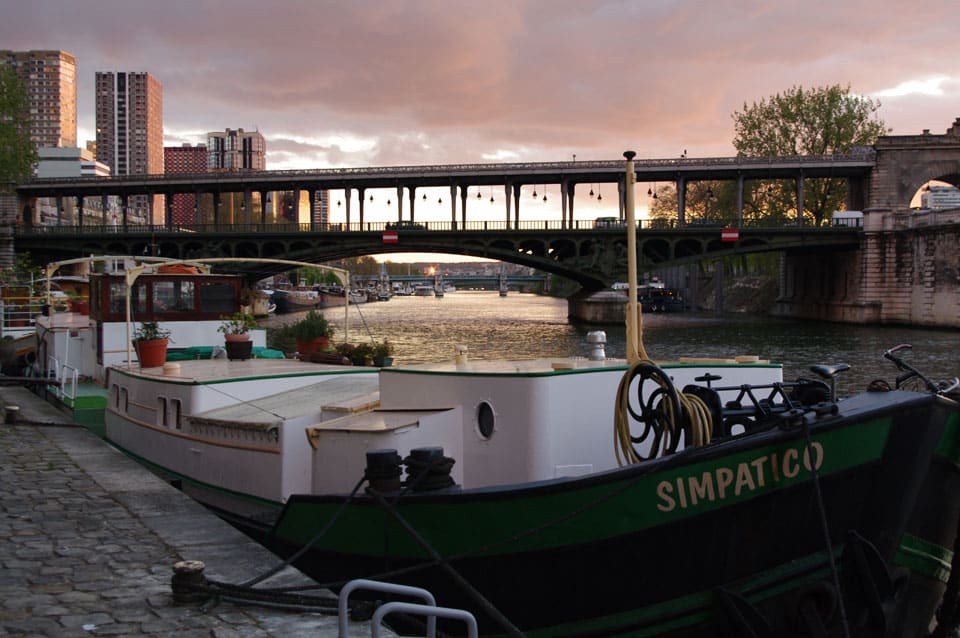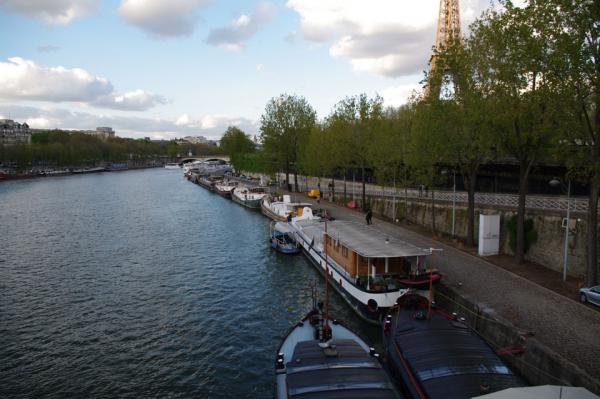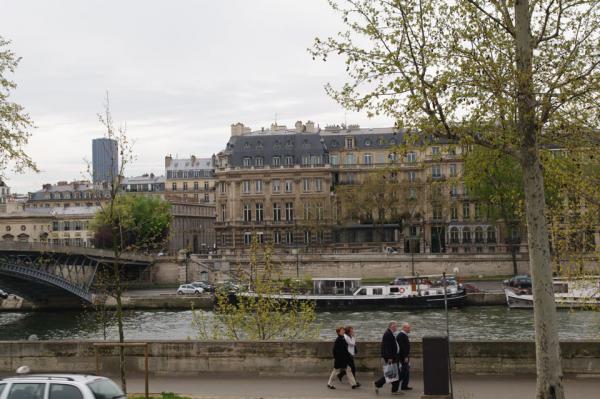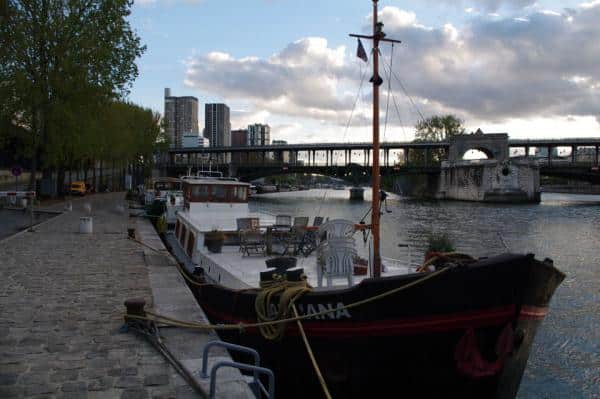
Paris Live-Aboards
The romance of Paris is so well known that it’s passed common knowledge and entered the kingdom of extreme cliché. I am almost embarrassed to be as charmed by the City of Lights as I am. And yet, I cannot resist the effortless style of Parisians, the brasserie windows full of lovingly arranged iced shellfish, the sight of bicyclists wielding baguettes, the simple majesty of the Tuileries, the ancient streets of Le Marais, the flea market at Clignancourt and a hundred other facts of ordinary life in this lovely city. When I slip into one of my Walter Mittyesque trances about living in Paris, however, the pièce de résistance, for me, is the idea of living aboard along the Seine. On my last trip to Paris, I decided I’d get a more realistic view of what living aboard here is like (see the complete photo gallery).
I met Ahab Downer aboard Paros, a 100-foot peniche (cargo barge) that’s more than a century old and was originally used to commercially transport coal, mail, wine, beer and grain. Living aboard is a family affair for the Downers — Ahab’s father has a beautiful Dutch barge, Adriana, on the same quay as Paros, a French barge that belongs to Ahab’s mother. Port de Suffren, where they’re tied up, is a stretch of the Seine near the Bir-Hakeim metro station, which means that in addition to a lovely view of the river and the Beaux Arts architecture of Passy, they have the Eiffel Tower looming above their starboard bow. It’s simply ridiculous and, I immediately realized, unlikely to deflate my fantasies one little bit.
Downer families have been living aboard in Paris since 1980, and Paros has most recently been home to Ahab, his wife and their two small children. Ahab says there are fewer than 150 live-aboard boats in Paris. Just about the only way to get one of these coveted spots is to buy a boat that already has one — otherwise there is a very, very long waiting list. The mooring fee for a boat of Paros‘ size is about €1,000 per month, which is, of course, impossibly cheap for a home of this size and space in Paris.

The pros of life aboard in Paris are undeniable. “The Seine creates an open space, not unlike a park,” says Ahab. “There are no buildings, no people milling about, nothing to block the view, the sky, the sun … the feeling of open space is a big plus.” Another benefit is the famous Parisian light reflected off the river. And, of course, should you ever tire of this stunning view, your home can move.
Ahab’s father cruised Adriana through the canals of Burgundy during his first full summer aboard and he still tosses off the lines occasionally. Many of the live-aboard boats along the Seine don’t move at all — they are decorated with flowers, shrubs — even small trees — deck furniture, bicycles, grills. But there are many peniches that still look shipshape and ready to cruise.
I can imagine the dilemma. While exploring the canals and rivers of France would be hard to resist — they’re extensive enough to provide years of cruising — leaving Paris would be nearly impossible. And as with any good neighborhood, there’s a real sense of community among the live-aboards. They keep an eye on each other’s barges in bad weather or when someone goes away for the weekend; they host parties and barbecues in the summer months; they are friends and neighbors and — in Ahab’s case — family.

Of course, there are some drawbacks to the situation. The traffic on the river is steady, and at times the passing lights of the highly decorated bateaux mouches full of tourists can be annoying. There are occasionally drunk and uninvited guests who have to be chased off the deck of Paros, Ahab admits. There’s no super to call when things go wrong, and this is, after all, a boat, with the more complex electrical, tankage and other maintenance issues we all know and love. And then there are those famously long, gray winters in Paris — and the occasional flood.
“We had to take a boat from our boat to reach the quay!” says Ahab of last year’s flood.
Four hundred eighty-two miles long, the Seine rises from Saint-Seine near Dijon and empties into the English Channel at Le Havre. More than half of its length is navigable by commercial boats, though seagoing vessels can come only as far as Rouen, about 75 miles upriver from the channel. This tidal section of the Seine Maritime is followed by a canal with four large locks leading to the mouth of the Oise River at Conflans-Sainte-Honorine. Multiple locks at Bougival/Chatou and Suresnes lift vessels to the level of the Seine in Paris, where it meets the Marne River. (The Paris stretch has 37 bridges!) The average depth of the Seine, which is dredged and controlled by locks, is about 31 feet, and the current can be brisk. Upstream from Paris eight locks allow navigation to meet Montereau-Fault-Yonne. From here, larger ships can continue upstream to Nogent-sur-Seine. After this point, the waterway is navigable only by small vessels, and all navigation of the river ends completely at Marcilly-sur-Seine.

Of course, not all the Paris moorings, long-term or transient, are along the banks of the Seine. The Port de Plaisance de Paris-Arsenal is probably the best known mooring for visiting private vessels. The north end of the marina is wonderfully located at the foot of the Place de la Bastille. The Bassin de la Villette, in the 19th arrondissement, links the Canal de l’Ourcq to the Canal Saint-Martin. Or for a really central mooring (on the Seine) that reminds you every day that you’re on a boat, in Paris! there are sought-after transient spots available in front of the Grand Palais and Place de la Concorde, at the eastern end of the Champs Élysées. Like the long-term moorings in Port Suffren, these are managed by VNF (Voies Navigable de France), the national waterway authority, rather than by the city of Paris as at the other basins.
I know I have a tendency to romanticize the possibilities of life abroad — especially life aboard a boat. But I should have known that no one out-romances Paris. _Imbécile!
_See the complete photo gallery.









